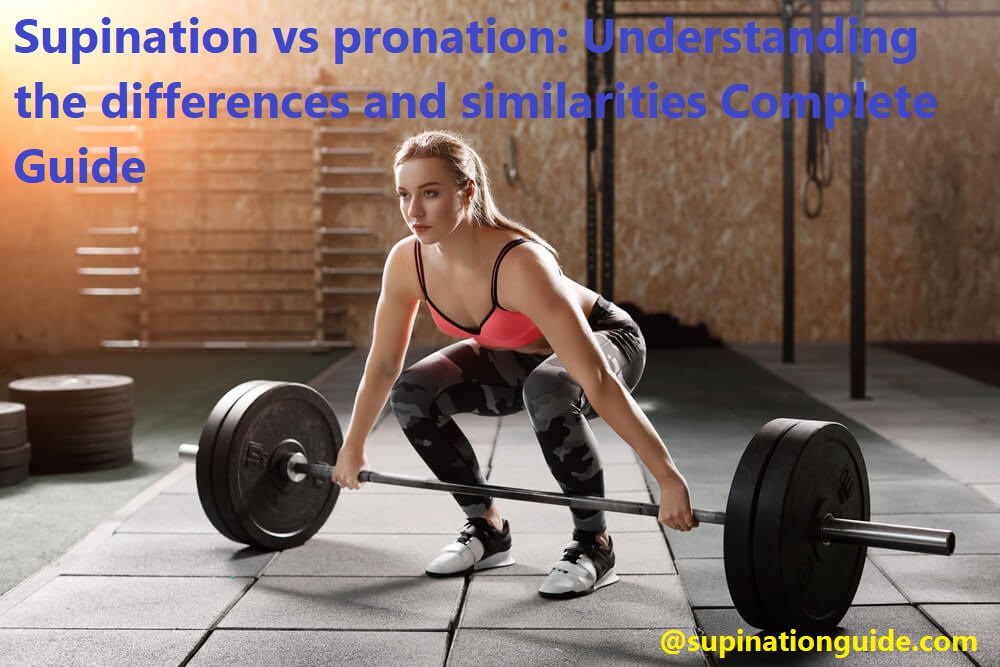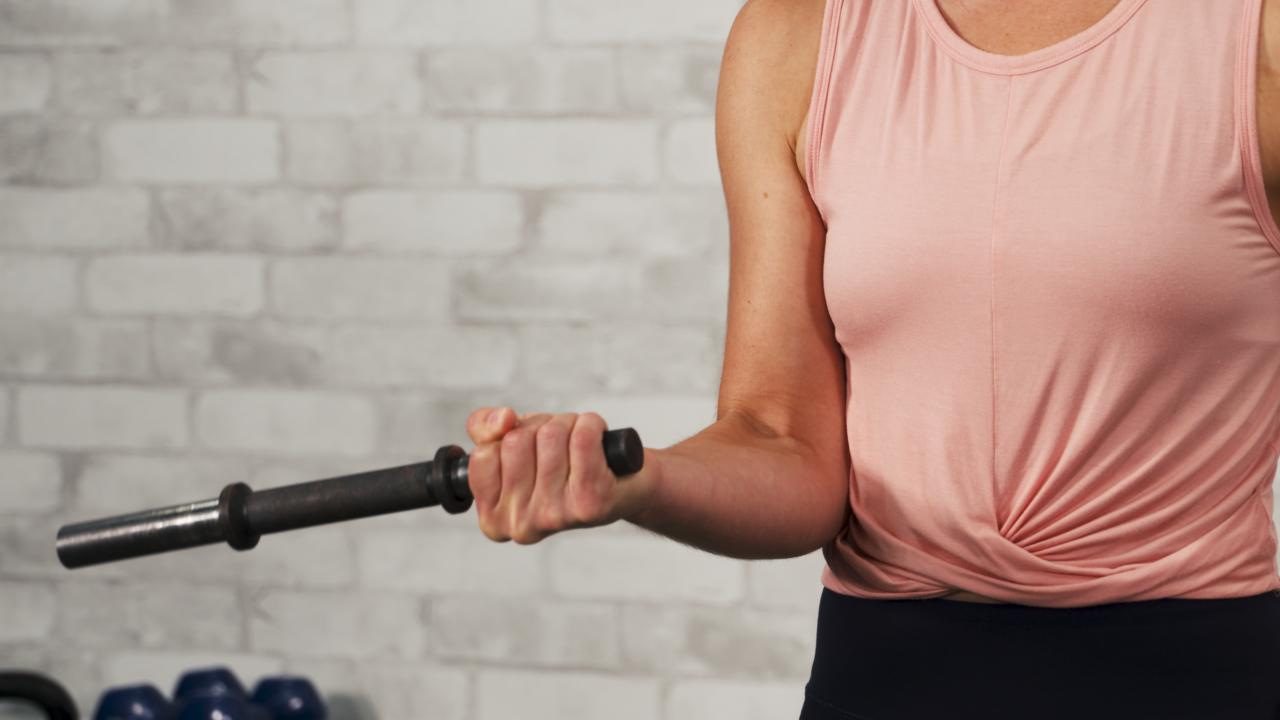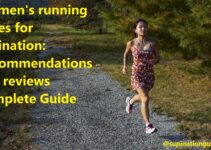Are you wondering what the difference is between supination and pronation? You’re not alone! It’s important to know the differences between these two movements to ensure proper joint stability, enhance athletic performance, and reduce risk of injury.
In this guide, you’ll discover the similarities and differences between supination and pronation — so you can more efficiently keep your body in balance.
It is widely accepted that having a good understanding of supination and pronation is key to developing a comprehensive exercise and strengthening program. Both of these terms refer to the degree at which the feet rotate inwards or outwards, respectively. Supination and pronation play an integral role in helping to maintain proper body balance and alignment during movement, with notable effects on muscles, ligaments, tendons, posture and especially when running or walking.
In this guide we will explore the differences between supination and pronation as well as provide insight into potential causes for each motion type. Additionally, tips for helping to promote good posture and strengthening programs utilizing both supination and pronation will be discussed.
Supination
Supination is an essential part of the walking and running cycle. It is a movement that occurs when you roll your foot to the outside as it hits the ground, creating an outward turning force. This rotation helps to disperse and distribute weight, absorb shock, and maintain balance as you move along your path. Supination works in conjunction with pronation — another key action in gait — to not only keep you upright but also propel you forward.
As your foot strikes the ground, initially the heel helps create a gradual deceleration of your body’s motion while starting pronation and soak up impact force before finally transitioning into supination as you drive off with your toes. During this stage, muscles throughout your foot and ankle contract to elevate your arch and rapidly bring about supination. If done properly, this allows for maximum efficiency in terms of shock absorption and movement execution. To visualize supination simply imagine stepping onto flat ground with an out-turned shoulder position or slightly rolling over an imaginary cylinder located at mid-foot or beyond toe box area on the inner side of each shoe sole.
Supinated feet are typically associated with higher arches which offer additional stiffness than their neighbours — the neutral or pronated feet – allowing for less flexibility but more stability from contact through propulsion phase during walking/running cycle enabling efficient support for heavier loads or activities requiring repeated hard impacts such as running on concrete roads or playing football/volleyball etc.. A study by Taunton et al (2003), showed that athletes tend to be more prone to suffering ankle injuries due primarily due to their increased tendency towards faster speeds of movement whilst being more rigidly built leading them believe they can jump higher than usual…so without proper flexion which allows balance & control over pronation & supination behaviour especially at times when changing direction suddenly – risk factors worsen substantially!

Definition and explanation of supination
Supination is a biomechanical term used to describe the rotation of the forearm and foot. It refers to the outward rotation of the hand and foot so that the front is facing upward and the palm and sole are both facing out. Supination helps maintain stability, balance, and proper posture while walking, running, or performing other activities with our arms or feet. Supination is typically seen during movements like pushing up from a sitting position, while pronation is seen in movements like stopping your forward motion when you’re walking or running.
Supination provides increased stability because it positions your hand and foot so they don’t roll inwards on surfaces when you are standing or walking on uneven terrain. It also positions your feet with feet slightly apart when you stand to allow them to bear weight more evenly. During toe off in running or stair climbing, supination helps generate power by creating a strong base of support for takeoff with minimal energy loss due to bending motions. This effectively transfers power through the body more effectively for propulsion forward by giving an unwavering platform for stabilization throughout all phases of movement.
Finally, supinated posture can also help facilitate better breathing as this position opens up chest cavity space expanding lung capacity which can be seen during light-moderate aerobic exercise such as running intervals on flat ground. Increased breathing means better oxygen circulation which helps maintain performance levels for longer duration of activities such as competitive marathons races, etc..
Description of the foot and ankle positioning during supination
During the supination movement of the foot and ankle, the outer side of the rearfoot rolls outward. The talus will lean in an inverted position, lowering heel in its medial side, which allows for greater push off power at toe off. This position also helps to create a more rigid platform for push off.
The subtalar joint pronates or everts slightly which results in abduction of the forefoot. The plantarflexion of the ankle contributes to a flexible propulsive surface by preparing to absorb shock during ground contact, storing elastic energy like a springboard at push-off on toe lift-off.
As supination continues, it accompanies adduction and abduction motion at hip joints while mobilizing lumbar spine muscles to protect core stability with less torque at vertebral discs as compared to when pronation is initiated.
Examples of activities that involve supination
Supination is a form of movement that refers to the action of rotating the hand, arm or foot outward. It is the opposite of pronation and typically involves activities like gripping hammer with your hand or pushing off against the ground with your feet.
Examples of activities that involve supination include:
- Turning a doorknob.
- Holding a handlebar on a bicycle and twisting outwardly on the bars when riding.
- Typing on a keyboard or tapping away on your phone screen.
- Using hand tools such as screwdrivers and hammers, which require a supinated grip to carry out the task effectively.
- Picking up heavy objects in your arms by gripping with an upward rotation in opposition to gravity (e.g., picking up something from floor height).
- Driving, where you need to push outwards on the steering wheel to turn it properly.
- Pushing into walls when doing plyometric exercises or agility drills; these will often involve an outward/supinated direction for pushing oneself away from obstacles/the wall as fast as possible.
Pronation
Pronation is a type of movement that the foot and ankle make when walking, running and during everyday activities. It involves the downward rotation of the foot so that the sole faces inward as pressure moves through it. During pronation, the tarsal bones and muscles of the foot move in coordination to absorb shock, enabling us to walk on uneven surfaces and maintain balance.
Pronation also helps distribute body weight evenly across the heel, arch, and ball of the foot – making it an important part of any healthy gait cycle. Prolonged periods of overpronation can cause a variety of common foot ailments such as plantar fasciitis, bunions and neuromas. Therefore, it’s important to be aware of your pronation type in order to address any potential issues quickly before they become problematic.
:max_bytes(150000):strip_icc()/Pronated-Supinated-Grips-GettyImages-534213550-2000-71a6507df9a344488bcbca88f830224d.jpg)
Definition and explanation of pronation
Pronation is a type of foot movement that results in the inward rotation of the foot and serves to act as a shock absorber when we walk or run. This type of movement takes place when the outside edge of the heel strikes the ground which causes the foot to roll inward, engaging muscles and ligaments leading to an absorption of shock.
The term pronation is derived from Latin “prōnantem” (“leaning forward”) and is an anatomical term used by healthcare specialists, such as physical therapists and podiatrists. Pronation can be identified through static tests where specific points on the feet will register as hyperpronated (too much pronation) or under-pronated (not enough pronation) depending on how much weight there is on each area. Hyperpronation can cause pain in various parts such as heel and knee while under-pronated (or high arch) may increase the risk for ankle sprains.
The normal range for pronation varies for different individuals, but typically spans from 5˚ to 24˚ when viewing from a medial view which equates to 3˚ ab/adduction (away from/towards midline) when viewed from lateral side. The degree also depends on body size, symmetry, flexibility, etc. It is important to understand these ranges when attempting corrective exercises or incorporating orthotics into rehabilitation programs such as treating an ankle sprain where being highly pronated may increase risk of injury for certain movements or activities if not properly corrected.
Description of the foot and ankle positioning during pronation
The ankle is positioned in a slightly plantarflexed position during pronation which means that the toes are lower than the heel. The calf muscle, tibialis anterior and the shin muscle, Gastrocnemius, are contracting and pulling the foot down towards the ground (inversion of the foot occurs) as it moves into this neutral stance. During this phase, weight is transferred onto the arch of the foot; it forms a cushion like surface that can handle various kinds of pressures.
The arch compresses and spreads evenly as body weight passes over it. In addition to inversion of the foot, adduction also occurs at this point which is transfer of energy from medial to lateral motion in order to help with making small corrective adjustments during mid-stance phase.
This combination allows for a more comfortable pronated gait cycle as compared to supination where adduction does not occur and no cushioning takes place underfoot when body weight passes through its stance phase.
Examples of activities that involve pronation
Pronation is the natural movement of the foot as it rolls inward during activities such as jogging or walking. This movement helps the foot adjust to uneven surfaces, absorb shock and support body weight. It also allows muscles, tendons and ligaments to work together efficiently. Each time the arch of the foot lowers, toes will spread and grip the surface below it for balance.
Examples of activities that involve pronation include running, walking, tennis, volleyball and ballet. By understanding how the body’s structural makeup affects pronation and supination you can make an informed decision when selecting footwear for physical activity.
Differences and Similarities between Supination and Pronation
Supination and pronation are two opposite motions that the body uses to control the orientation of the forearm while performing movements. When practicing any kind of physical activity, it is important to understand how these movements differ in order to perform more efficiently with less chances of injury.
The main difference between supination and pronation is that when supinating, your palms face up and pronating, your palms face down. When looking at a person’s hand from above, a clockwise motion will be considered as pronation and a counter-clockwise movement will be seen as supination. The two motions, similar to most rotational joint movements, require rotation from both the underlying bones and the muscles located in your forearm which gives you full range of motion and stability throughout different activities such as throwing or swinging a bat or club in sports or even just writing or typing on a computer.
Supination and pronation need for coordination with each other in order for them to work properly especially when doing more complex activities like walking; where you will be needing an appropriate amount of both motion together in order to maintain balance correctly. Supinated feet strike on the outside part while pronated feet strike on the inside while landing differently when walking or running , thus making sure you have an effective stride length during these types of physical activities.
An additional similarity between supination and pronation is that they both allow your radius bone- one of two bones forming your forearm -to rotate around its longitudinal axis; creating what medical professionals refer to as rotational joint movement by combining both actions which form an essential part fundamentality when moving our arms . As previously mentioned these motions are activated by muscles found on our forearms but also through those surrounding it such as biceps brachii & brachialis which increase muscle strength required for any type of activity that involves rotating our arms through space .

Comparison of the foot and ankle positioning during supination and pronation
Supination and pronation are two essential movements of the foot and ankle that occur when walking and running. Both of these motions help the body to adjust to uneven terrain and external forces, while also providing stability, by enabling the foot and ankle to absorb shock.
When your foot moves into supination, the leading edge is forced outward (outward roll), meaning your sole will face outwards as you move forward. During this movement, your tibia crosses over top of your other leg compensating for the outward push. To help with this balancing act an arc is created in the arch of your foot, cushioning each stride with a more vertical position of the ankle than that seen in pronation. This outward facing direction increases surface area at the heel thus stabilizing you further.
Likewise, pronation occurs when your foot rolls inward (inward roll). When your lower leg crosses over top of itself as it does during supination but it does so going inward instead of outwardly forcing it face inward towards the other leg for a stable landing where body weight is typically shifted onto one feet’s outer portion – known as eversion (increasing surface area away from midline. This helps maintain balance by spreading out weight on either sides while shifting bodyweight slightly forwards or backwards on a regular stride path depending upon speed and direction being followed during motion.
The difference between supination and pronation can be visualized with a pair of hands together palms up; supination is like placing one hand over top to create an outwards-facing orientation while pronation is like placing one hand under bottom after folding fingers inwards towards thumb creating an inward-facing orientation instead. The positioning of both feet and ankles during those motions creates different angles between legs which determines traction on any given surface level resulting in varying amounts stability while moving otherwise uniform directions necessary for running or walking activities comfortably without pain due situation call instability coupled with inability flat feet people to successfully maintain acceptable posture standing still standing long periods time simultaneously avoiding potential falling potential slipping injuries accounted misalignment strucutres affected delicate balance systems requiring correct functioning along sensitive neural pathways order reduce risk sudden unexpected events support spine within most appropriate environment conducive healthy lifestyle choices anyone’s best interests review longterm health outcomes accordingly moving ahead exciting future opportunities acting today’s present present engagements sense assured satisfaction feeling accomplishment completion bringing materials dreams manifest form happen dreams real possibilities lead facts information fill lifetime memories unforgettable extent influence extraordinary powerful no matter circumstance.
Explanation of how supination and pronation relate to each other
Supination and pronation, while related, are distinctly different terms. Supination is a rotation of the forearm that involves turning the palm up or outward. Pronation is a rotation of the forearm which involves turning the palm down or inward. Supination and pronation can occur together during many movements such as walking and exercising, but they also have their own distinct functions in certain activities.
The most common distinction between supination and pronation lies in their involvement in human locomotion — supination generally provides stability when your back foot is planting for a walking stride, whereas pronation allows for increased flexibility with joint movement around the foot as it is driven off to complete the stride. When engaging in exercises such as lifting weights, one typically pushes through from a state of supinatoin or push up position to reach full arm extension. In contrast, return to starting position will involve pronational movement to allow for muscles such as upper arm triceps muscles to become fully engaged while dumbbells are returned back into shoulder angle.
Supination has more direct implications on posture — as it helps turn shoulders outward which increases torso stabilization by helping counteract hunching over that may occur due to imbalance within other bodygroups such as leg muscles-leading people with naturally tight ankle muscles towards potential injury if not addressed prior continued exercise progression within sport activities; this maintenance of good posture helps reduce occurrence others physical complaints caused by poor posture while increasing strength throughout both upper body core movements additional power outputs from lower.
The same applies during shoe selection–as surefootedness during activities such as running requires understanding how your gait will interact with shock reduction qualities particular shoes independently monitored by rorofessional coaches based upon student individual’s needs–not only does it influence arch support suppleness required due to stresses experienced during particular times physical exertion, but also about road type surfacesoftness for outdoor joggers plan ahead accordingly customize choices running exercises accordingly…
Discussion of the roles of supination and pronation in movement and stability
Supination and pronation are two movements that occur in our bodies when we move, which are fundamental for motion and stability. Supination and pronation refer to the exact same movements of the forearm, it’s just the perspective of the observer or person looking at or performing the movement that differentiates them. When a person rotates their humerus (upper arm bone) externally with the palms facing up, this is supination. Pronation is the exact opposite—the palms face down as if in a bowl position once more rotation has occurred with the upper arm bone.
Supination is responsible for making it possible for gripping objects like utensils, guns, or tools without straining our hands and wrists. In fact, both supination and pronation enable us to perform a variety of everyday activities such as lifting weights or carrying groceries, playing sports, writing or typing on a keyboard. Furthermore, understanding how to perform these biomechanical motions help us prevent injuries by giving us control over our movements at all times during daily tasks as well as exercising sessions.
Supination is usually associated with elbow flexion that closes the joint angle while pronation has to do with elbow extension opening up this angle at any given point in time; nevertheless they work together since supinators need strong prontors (muscle structures responsible for extending the elbow) and pronators need strong supinators (those that flex the elbow) for efficient biomechanics throughout exercise routines and life activities without contributing to repetitive motion injuries. This brief description of these two common motions helps outline their functionality however ultimately what needs to be understood is that alongside providing us with more stability general movements become significantly stronger with better coordination between muscles upon application of proper technique related to these specific mechanics in both exercise sessions and life tasks through relevant programs crafted by healthcare experts including physical therapists among other healthcare professionals who can identify dysfunctions affecting proper movement patterns upon assessment regardless if one experiences pain or not.
Conclusion
In conclusion, it’s important to understand the differences between supination and pronation in order to choose the correct footwear for your activity. In general, a neutral footstrike which combines elements of both is best for most everyday activities. It’s also a good idea to have your gait checked by an expert in order to make sure you’re using the right equipment to minimize any risk of injury when performing physical activities.
Given that biomechanics are such a crucial part of running, it pays off to learn more about how our body works and its functions while running or walking on various surfaces. It’s also essential to develop an understanding and appreciation of how pronation and supination influences our footstrike and gait cycle so that we can choose the right footwear for our needs.

FAQ’s
What is the differences between supination and pronation?
Supination is the movement of turning the palm upward, while pronation is the movement of turning the palm downward.
How to remember the difference between pronation and supination?
One way to remember the difference is to associate the “p” in pronation with the “p” in palm-down, and the “s” in supination with the “s” in palm-up.
What is the difference between supinator and pronator muscles?
Supinator muscles are responsible for supination, while pronator muscles are responsible for pronation.
What is the difference between supination and pronation of hand?
Supination of the hand is the movement of the forearm and hand turning the palm up, while pronation of the hand is the movement of the forearm and hand turning the palm down.
What types of movements are pronation and supination?
Pronation and supination are rotational movements.
Where does pronation and supination occur?
Pronation and supination occur at the radioulnar joint in the forearm.
What is the function of supination and pronation?
The function of supination and pronation is to allow the hand to be positioned in a way that is optimal for various activities.
What is the function of supination?
The function of supination is to allow the hand to be positioned with the palm facing upward, which is useful for activities such as carrying a tray or holding a cup.
What is an example of supination?
An example of supination is when you hold a bowl of soup with your palm facing upward.
What is an example of pronation?
An example of pronation is when you pour the soup out of the bowl by turning your palm downward.
See Also :
- Best athletic shoes for supination
- Best brooks shoes for supination
- Best hiking shoes for supination
- Best hoka shoes for supination
- Best insoles for supination


